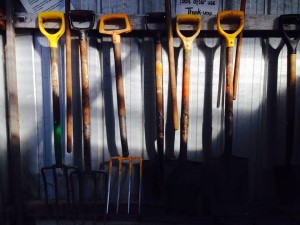By Wen (Plot 223)
Question: My compost is not breaking down – it looks wet and/or smells bad.
Answer:
Why it happens – Compost that is too wet will not allow enough air for aerobic microbes (the good ones) to survive, so the anaerobic ones (the bad ones) take over. They can produce foul smelling gases.
How to fix –
- Add some ‘brown’ dry material, such as straw, saw dust, dried leaves or old dried lawn clippings (do not use fresh lawn clipping if your compost is too wet) to your compost each week.
You can also add shredded newspaper (not glossy printed materials as they contain toxic inks) and kitchen paper towels – as long as they do not contain oil, liquid from meat/dairy products or anything cooked, such as soup. - Turn your compost when adding layers of the ‘brown’, dry materials to the existing compost. Turn it at least 2-3 times a week.
- Ensure your compost bin can drain freely (go out and check the bin when it is raining dogs and cat – well, take an umbrella with you – you should see rain water coming out from the bottom of the bin).
Even better, cover your compost to prevent rain entering.
Outcome – The compost should look like a wet blanket, not dripping wet and not bone dry. This will be the perfect condition for the worms and bacteria to break down the compost.
Question: My compost is not breaking down – it looks dry.
Answer:
Two things you can do – water it and add more ‘green’ materials.
- Water your compost bin at least once a week in summer. In Winter, if your bin is dry, you can put in a bit of water until it starts to heat up – you can see the steam coming out in the early winter mornings.
- Also, change the mix of materials you are putting in by adding more ‘green’ materials – wet/green leaves, garden pruning, small amount of fresh lawn clippings, fruit and vegetable scraps.
Please be careful with lawn clipping. If a large amount of fresh clippings are put in the bin, it will compact down, forming a layer that stop air movement. This kills all the bacteria and micro-organism and, as a result, stops the composting. There are ways to use lawn clippings in composting, such as drying them up, mixing with ‘brown’ materials, aerating them, etc. The easiest way I find is to use a small amount, sprinkle them into the bin so they won’t form a layer.
Outcome – The compost should look like a wet blanket, not dripping wet and not bone dry.
Question: Swarms of flaying objects are coming out of my compost bin. Help!!
Answer:
Ok, there is no alien breeding in the bin. It is possibly vinegar flies and their cousins.
What they are telling you is your bin is a bit too wet.
- Add brown (dry) materials – straw, saw dust, dried leaves, dried lawn clippings, shredded newspaper or kitchen paper towels .
- Turn the compost at least 2-3 times a week.
- Check if the bin is draining properly.
For quick result to get rid of the aliens – scatter lime into the bin until there are no more flies.
Check out the three bins in Plot 223 (Wen). They are not prefect but compost are harvested every 3-6 months!
Other useful resources:
- The Benefits of Composting (Jane Edmanson, ABC Gardening Australia)
- Managing Compost (Jane Edmanson, ABC Gardening Australia)
- How to Compost – Learn the Basics (SodGod – thanks to Tyler at Green Teens Club)

